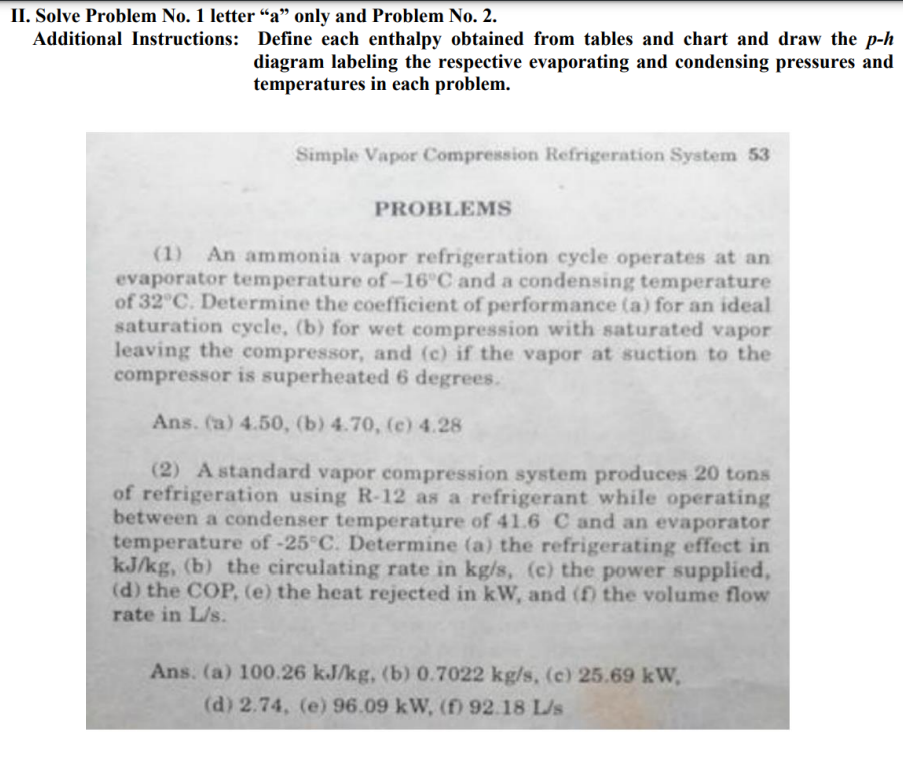PROBLEMS (1) An ammonia vapor refrigeration cycle operates at an evaporator temperature of-16°C and a condensing temperature of 32°C. Determine the coefficient of performance (a) for an ideal saturation cycle, (b) for wet compression with saturated vapor leaving the compressor, and (c) if the vapor at suction to the compressor is superheated 6 degrees. Ans. (a) 4.50, (b) 4.70, (e) 4.28 (2) A standard vapor compression system produces 20 tons of refrigeration using R-12 as a refrigerant while operating between a condenser temperature of 41.6 C and an evaporator temperature of -25°C. Determine (a) the refrigerating effect in kJ/kg, (b) the circulating rate in kg/s, (c) the power supplied, (d) the COP, (e) the heat rejected in kW, and (f) the volume flow rate in L/s. Ans. (a) 100.26 kJ/kg, (b) 0.7022 kg/s, (c) 25.69 kW, (d) 2.74, (e) 96.09 kW, (f) 92.18 L/s
PROBLEMS (1) An ammonia vapor refrigeration cycle operates at an evaporator temperature of-16°C and a condensing temperature of 32°C. Determine the coefficient of performance (a) for an ideal saturation cycle, (b) for wet compression with saturated vapor leaving the compressor, and (c) if the vapor at suction to the compressor is superheated 6 degrees. Ans. (a) 4.50, (b) 4.70, (e) 4.28 (2) A standard vapor compression system produces 20 tons of refrigeration using R-12 as a refrigerant while operating between a condenser temperature of 41.6 C and an evaporator temperature of -25°C. Determine (a) the refrigerating effect in kJ/kg, (b) the circulating rate in kg/s, (c) the power supplied, (d) the COP, (e) the heat rejected in kW, and (f) the volume flow rate in L/s. Ans. (a) 100.26 kJ/kg, (b) 0.7022 kg/s, (c) 25.69 kW, (d) 2.74, (e) 96.09 kW, (f) 92.18 L/s
Refrigeration and Air Conditioning Technology (MindTap Course List)
8th Edition
ISBN:9781305578296
Author:John Tomczyk, Eugene Silberstein, Bill Whitman, Bill Johnson
Publisher:John Tomczyk, Eugene Silberstein, Bill Whitman, Bill Johnson
Chapter47: High-pressure, Low-pressure, And Absorption Chilled-water Systems
Section: Chapter Questions
Problem 13RQ: The subcooling temperature in a condenser can be measured by taking the difference between the A....
Related questions
Question
Provide clear and complete solution including diagrams

Transcribed Image Text:II. Solve Problem No. 1 letter "a" only and Problem No. 2.
Additional Instructions: Define each enthalpy obtained from tables and chart and draw the p-h
diagram labeling the respective evaporating and condensing pressures and
temperatures in each problem.
Simple Vapor Compression Refrigeration System 53
PROBLEMS
(1) An ammonia vapor refrigeration cycle operates at an
evaporator temperature of -16°C and a condensing temperature
of 32°C. Determine the coefficient of performance (a) for an ideal
saturation cycle, (b) for wet compression with saturated vapor
leaving the compressor, and (c) if the vapor at suction to the
compressor is superheated 6 degrees.
Ans. (a) 4.50, (b) 4.70, (c) 4.28
(2) A standard vapor compression system produces 20 tons
of refrigeration using R-12 as a refrigerant while operating
between a condenser temperature of 41.6 C and an evaporator
temperature of -25°C. Determine (a) the refrigerating effect in
kJ/kg, (b) the circulating rate in kg/s, (c) the power supplied,
(d) the COP, (e) the heat rejected in kW, and (f) the volume flow
rate in L/s.
Ans. (a) 100.26 kJ/kg, (b) 0.7022 kg/s, (c) 25.69 kW,
(d) 2.74, (e) 96.09 kW, (f) 92.18 L/s
Expert Solution
This question has been solved!
Explore an expertly crafted, step-by-step solution for a thorough understanding of key concepts.
Step by step
Solved in 6 steps with 6 images

Knowledge Booster
Learn more about
Need a deep-dive on the concept behind this application? Look no further. Learn more about this topic, mechanical-engineering and related others by exploring similar questions and additional content below.Recommended textbooks for you

Refrigeration and Air Conditioning Technology (Mi…
Mechanical Engineering
ISBN:
9781305578296
Author:
John Tomczyk, Eugene Silberstein, Bill Whitman, Bill Johnson
Publisher:
Cengage Learning

Refrigeration and Air Conditioning Technology (Mi…
Mechanical Engineering
ISBN:
9781305578296
Author:
John Tomczyk, Eugene Silberstein, Bill Whitman, Bill Johnson
Publisher:
Cengage Learning